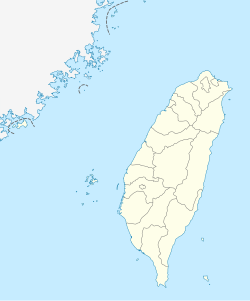Yilan Airfield
| Yilan Airfield | |||||||
|---|---|---|---|---|---|---|---|
宜然机场 | |||||||
| Yilan, Taihoku Prefecture (now Taiwan) in Taiwan | |||||||
 Aerial photography of Giran Airfield, 1944-1945 | |||||||
| Site information | |||||||
| Owner | Kuomintang | ||||||
| Operator | Republic of China Air Force | ||||||
| Controlled by | Kuomintang | ||||||
| Open to the public | No | ||||||
| Location | |||||||
| Coordinates | 24°43′56″N 121°45′04″E / 24.73222°N 121.75111°E | ||||||
| Site history | |||||||
| Built | 1936 | ||||||
| Built by | Japanese Army | ||||||
| In use | 1936 - 1973 | ||||||
| Fate | Dismantled | ||||||
| Battles/wars | Pacific War | ||||||
| Airfield information | |||||||
| Identifiers | ICAO: RCMS | ||||||
| |||||||
Yilan Airfield (ICAO: RCMS) (also known as Giran Airfield) is an abandoned airfield located in Yilan, Taihoku Prefecture, Taiwan.
This airport is not to be mistaken with Yilan Airport (IATA: YLN), an abandoned airport in Yilan County, Mainland China.
History
[edit]Yilan consisted of 3 airfields, south, north and a west airfield which was considered “secret”. The southern airfield was known as Giran Airfield.
In 1925, a reconnaissance aircraft flew from Hualien to Yilan, landing at the Jinliujie Army Training Ground. The pilot briefly rested before returning back to Hualien, making the event as the first time Yilan residents saw an “iron bird’ land. It also served as a psychological show of force by the colonial authorities.[1]
Giran Airfield was constructed in 1936 provided by demanding labour of students from the nearby agricultural college. The airfield was mostly built using hands, and little to no equipment and machines were used. The airfield was completed by 1938 with compacted earth reinforced runways with stone rollers, which was prone to flooding from the nearby Yilan River. Shortly after the completion, torrential rainfall submerged the runway, which underwent significant repairs and resumed operations by the end of 1938. From 1936 to 1938, Japan Air Transport served a route to this airfield.[2] In 1939, the airfield was acquired by the Kuomintang Government (KMT), and the airfield was operated as a weather observation station, with a nearby meteorological observation building.[3]
On June 1939, the control tower was built, and the airfield was expanded to an area of 0,27 square kilometers, which was relatively small. On January 1940, a weather observation facility was established, which included a three-story wind observation tower constructed using reinforced concrete.[1]
World War II
[edit]On September 1943, Giran Airfield was requisitioned for military usage, which followed the Battle of Midway’s defeat in June 1942. The north airfield was reserved for airfield parking, while Giran Airfield was heavily utilized by kamikaze pilots. There were 14 camouflaged hardened aircraft shelters to concealed aircraft, as it was a popular bombing location by the United States Army Air Forces (USAAF). As the war progresses, students and locals were recruited to construct aircraft decoys using the nearby bamboo and install them on the wrong side of the airfield. However, this backfired, and allied pilots quickly noticed as there were no black smoke.[3]
Towards the end of the Pacific War, the Kamikaze crew were stationed inside dormitories of the agricultural college, forcing the students to sleep in make-shift huts or inside the hall. Over 2,500 pilots had flown from the airfield to suicidal missions against the Allied forces.[3] In 1944, a West Airfield, known as the secret airfield was constructed.[1]
Post-war usage
[edit]After the war in 1945, Giran Airfield was abandoned by the Japanese forces, however, the KMT quickly acquired the airfield when they arrived to Taiwan. The northern and secret airfield were dismantled. Giran Airfield was used as an emergency landing ground, and also as a weather station. The airfield was renamed to Yilan, was paved by 5000 feet, and maintenance facilities installed approximately on the north-eastern side. Yilan Airfield was later handed over to the Taiwanese navy, which stationed one PC-3 Orion aircraft on the airfield as an airborne early warning aircraft. There was plans by the Navy to expand and upgrade the airfield’s capabilities, however, it faced issues from the local government and nearby residents. These attempts were abandoned, and military was withdrawn along with the airfield closing down in 1973.[3]
Current usage
[edit]The site of the former three airfields were repurposed and their current usage are as follows:
- North airfield — currently the site of Yilan Reserve Command and Jinliujie Recruit Training Center of the R.O.C. Armed Forces
- South airfield — currently the site of Yilan Science Park of Hsinchu Science Park, Chengnan Campus of National Ilan University and Yilan Sports Park
- West airfield — currently the site of Kavalan Distillery
Raids
[edit]The following raids held on Giran Airfield.
- On March 13, 1945, Avenger bombers supported by 1844 Naval Air Squadron’s Hellcats and 1830 Naval Air Squadron’s Corsairs bombed the airfield, and damaged approximately 13 aircraft on Giran Airfield. The targeted aircraft may have been decoys or dummy planes.[4]
- On April 1, 1945, B-24 bombers of the 43rd Bomb Group (H) of the US 5th Army Air Force bomber Giran Airfield.
- On April 13, 1945, Avenger aircraft took off from HMS Victorious, en route back to the carrier after previously attacking Matsuyama Airfield strafed 12 aircraft on the ground at Giran Airfield.
- On April 18, 1945, bombers attacked Giran Airfield.[5]
- On April 16, 1945, B-24s and P-51s of the Far East Air Forces attacked Giran Airfield and Matsuyama Airfield.[6]
References
[edit]- ^ a b c 陳文樹 (October 2021). "宜蘭軍機場(上)" (PDF). Ministry of National Defense, Taiwan. Retrieved 8 December 2024.
- ^ "太陽新聞社 昭和6年日本航空業発展史". 日本交通文化博物館. Retrieved 16 November 2024.
- ^ a b c d "Yilan Wartime Airfield". GuanXi Media. Retrieved 15 November 2024.
- ^ "1833 Squadron". Royal Navy Research Archive. Retrieved 15 November 2024.
- ^ "Giran Airfield". WW2 Database. Retrieved 15 November 2024.
- ^ "April 16, 1945". Pacific Wrecks. Retrieved 15 November 2024.


 French
French Deutsch
Deutsch



